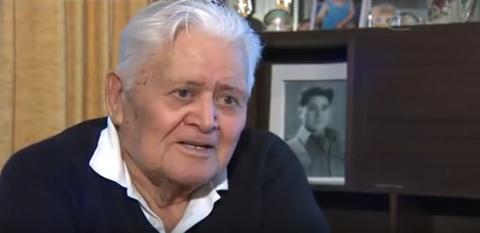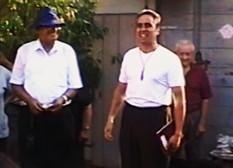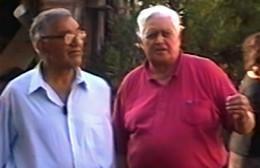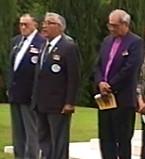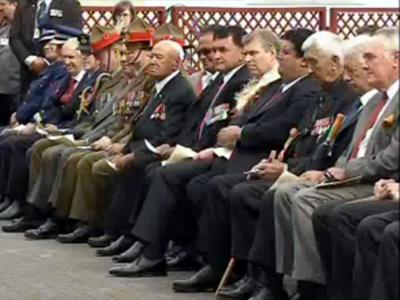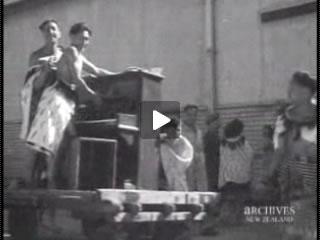<p>A news item with C Company veteran Hingangaroa Smith before the closing of the 28th (Māori) Battalion Association in December 2012.</p><p>Hinga went to sign up as a 16-year-old. He found out he had been adopted and that the name he was known as (Major Jackson) was not that listed on his birth certificate.</p>
Media library
Video
<p>This Te Karere item is provided via <a href="https://www.youtube.com/watch?v=JotqWv3MSpg" target="_blank">Youtube</a> </p>
<p>Haare Te Nuku Ratana, from Te Whānau Pani of Ngāi Tūhoe embarked for war with the 10th Reinforcements and served with B Company of the 28th Māori Battalion. </p><p>Haare arrived at the battle front during the Italian campaign. He was with B Company during the terrible Cassino Railway action on 17-18 February 1944 that decimated A and B Companies. As Lt-Col Sir James Henare stated "Of the 96 men from Mataatua and Te Arawa who followed Monty Wikiriwhi into the railway station...26 came back...Of the 100 men from Te Taitokerau who followed me across the river Rapido...40 returned...Half of the fighting strength of the Maori Battalion was lost in a single day."</p><p>Haare learnt to play piano during the war and he kept playing after the war as can be seen in this video recorded during a veterans reunion at Taupō in 2010.</p><p>Haare married Tei Rangiaukume Nuku-Ratana Tihi and together they raised their family in the Rūātoki valley. He was a skilled hunter and his builder skills were put to great use helping to build Ōwhakatoro marae at Rūātoki.</p><p>On Sunday 22nd November 2015, Haare, the last Tūhoe veteran of the 28th Māori Battalion passed away. He was 94. <br />Haare lay in state at the marae he helped build. <br />“Tangi ai ō iwi, e koro, ki a koe. Ka riro atu nā koe, i ōhou tīpuna”<br /> Haere atu rā e koro, e moe, okioki ai</p><p> </p>
<p>Courtesy of Harima Fraser<br />Video recorded by Leanne Tamaki</p><p><strong>Photographs referenced in order of appearance:</strong><br /> Haare Te Nuku Ratana in 2007, courtesy of Harima Fraser<br /> Haare Te Nuku Ratana at the final luncheon for the 28th Māori Battalion Association at Wellington in December, 2012 (3 photos). Copyright Te Puni Kokiri. Photographer Michael Bradley.</p><p> </p>
<p><strong>During a tour to Italy in 1999 Barry Soutar conveys the story of an Italian soldier who lived at casa Della Cura near the towns of Forli and Faenza. C Company were tasked with capturing this and casas Pogliano and Baccarina on December 14th, 1944.</strong></p><h2>Transcript</h2><p><strong>Barry Soutar:</strong> He and his brother were living in the house. He was an Italian soldier in the Italian army and he deserted, he deserted the army to go fight for the freedom of Italy. And he and his brother were in this house, the Germans came and they took him at gunpoint from out the front of the house …. They took him at gunpoint around the back of the house over here and he knew he was going to die, and he ran. He and his brother ran and they went and lived in the mountains for 8 months. The only thing he carried with him was a blanket and his clothes. And Jo and I were here, we told him that my uncle got killed just across the road trying to attack this house. And he told me, he under, he really felt very sorry for us and that he could understand, he could not understand how a Maori man would come from 14,000 miles away to save his house. He couldn’t understand how 55 years later another Maori man could come just to find his uncle. And he said, your uncle and 7 of his cousins lost their lives in his front lawn. And he said I want to tell you that 45 of my relatives and friends had their throats cut by the fascists, over here. And he said, so therefore he could understand the feelings that were going through us. I told him in January that in September I would come back with my family. And I just told him – here’s my family.</p>
<p>Nga Taonga a Nga Tama Toa Trust</p>
<p><strong>C Company veteran Hingangaroa Smith recounts the action to capture the casas Pogliano, Baccarina and Della Cura near the towns of Forli and Faenza undertaken on December 14th, 1944. Veteran Nolan Raihania to his left provides support.</strong></p><p><strong>This footage was taken at Casa Della Cura during a tour to Italy in 1999.</strong></p><h2>Transcript</h2><p><strong>Hinga Smith: </strong>The railway line is there. 15 Platoon came down that side. 14 come down the middle and we come down the side there, 13. Ah, when they got to this house there were some Germans here and tanks and there were. And they got into a house over there, Lt Paniora, and uh and uh Sam and uh<br /><br /><strong>Hinga to Nolan Raihania:</strong> who was that Sergeant? ahh Wanoa<br /><strong>Nolan Raihania:</strong> Yes, Wanoa<br /><strong>Hinga Smith:</strong> Albert Wanoa. <br /><strong>Hinga to Nolan Raihania:</strong> Who else was there?</p><p><strong>Hinga Smith:</strong> Anyway there were a few that got caught in there. But the Germans were in there and the tanks around the back. But these fullas come out, these Germans had started stretching themselves and uh it was too much for those fullas in that house over there, they shot him. From there, from the house. And that’s when the German’s brought their tanks and blew the house down. With the fullas in it. But later on, in the afternoon, we’d uh, we called for smoke to come down and cover all this area so we could take off up the way we came. And we ended up that night being back where we started from. Because these Germans in here held us up with their tanks. <br />If I, if I could see the fulla that owns it.<br /><br /><strong>Nolan Raihania:</strong> We can’t fight next [?]<br /><br /><strong>*Hinga Smith:</strong> 13 was over there boy, in the house over there. We had to leave that house where these fullas [unintelligible]. Couldn’t get this house. Is the main road ... was along there somewhere ne? Is the road along there? He rori kai mua? Well that’s the road we were trying to cut. <br />And Sam and them was killed in a place away from this. If that fulla said there was a house over there, well that’s it.</p><p><strong>Nolan Raihania:</strong> The house is not there now?</p><p><strong>Hinga Smith:</strong> No it’s not there.</p><p><strong>*Hinga Smith:</strong> We left up there about 6 or 7. We came down the road, there used to be vineyards all the way up and we came down the tracks and the German’s had sown mines along the track, especially where 13 company. Blew fullas legs off, like Rongo, no Sam, Sam or Rongo or Peter’s. One of those fullas legs, it was here. And there were some Germans in the haystack over there, yelled out to ‘Comarade’ when we went past into the house.</p><p><strong>Monty Soutar:</strong> Was that your start line uncle? Was that your start line way back there?</p><p><strong>Hinga Smith:</strong> Yeah up in the hill.</p><p><strong>Monty Soutar:</strong> The one they called Ruatoria?</p><p><strong>Hinga Smith:</strong> Yeah, yeah, that’s it. Yeah, up there. Ruatoria’s up there. That’s where we all started from. When we came here, we came around the back and over there.</p><p><strong>Taina McGregor:</strong> Why did you fullas call it Ruatoria?</p><p><strong>Hinga Smith</strong>: Well, we had to have a starting line and uh, and uh</p><p><strong>Nolan Raihania:</strong> That was the code name</p><p><strong>Hinga Smith</strong>: That’s the code name we had.</p><p>[They couldn’t break the code]</p><p><strong>Nolan Raihania:</strong> They couldn’t break the code.</p><p><strong>Hinga Smith:</strong> It would have been alright in that house if they hadn’t shot these Germans that were walking around here. Yeah, if they’d left them alone, they wouldn’t have known they were in that house. Everything would’ve been alright.</p><p><strong></strong> </p>
<p>Nga Taonga a Nga Tama Toa Trust</p>
<div><p><strong>Veteran Nolan Raihania recites ‘The Ode’ at the Florence War Cemetery during a tour undertaken by C Company veterans and their families to Italy in 1999.</strong></p><h2>Transcript</h2><p>Age shall not weary them<br />Nor the years condemn<br />At the going down of the sun and in the morning <br />We will remember them<br /><br />E kore ratau e korouatia<br />Penei me tatau kua mahue ake nei<br />E kore hoki ratau e ngoikore<br />Ahakoa nga pehi o te ao hurihuri nei<br />I te toenga atu o te ra<br />Tae noa ki tona aranga ake<br />Ka maumahara tonu tatau kia ratau<br /><br /></p></div>
<p>Nga Taonga a Nga Tama Toa Trust</p>
<p>TV3 News coverage of the ceremony to honour Haane Manahi held at Te Papaiouru Marae, Ohinemutu, Rotorua on 17 March 2007. The award was attended by HRH Prince Andrew and recognised Manahi's actions during the battle of Takrouna,
Tunisia. </p>
<p>During the ceremony the 'Te Arawa Sword of Gallantry for Haane Manahi' was presented to 28th Māori Battalion veteran, Arthur Midwood. </p><ul><li><a href="/node/3908" title="Haane Manahi">Read more about Haane Manahi, DCM </a></li></ul>
Film provided via <a href="http://www.youtube.com/watch?v=NNslXwzlK4U&feature=PlayList&p=F…; by 'billymaoribattalion'.
<p>Film by Tolaga Bay Area School student Hine Parata-Walker of the reunion of the 28th Māori Battalion held at Te Poho ō Rāwiri Marae, Turanga on 21-23 March 2008. The film includes interviews with Dr Apirana Mahuika (youngest brother of <a href="/node/1582">Nepia Mahuika</a>), <a href="/node/1997">Sir Henare Ngata</a> and <a href="/node/2447">Nolan Raihania</a>. Tini Glover (<a title="See his record" href="/node/1279">Tautini Moana Karawa</a>) is seen speaking on the marae.</p><h2>Māori Battalion Reunion 2008</h2><p>The 28th Māori Battalion Association (Gisborne Branch) hosted the National Reunion at Te Poho ō Rāwiri Marae on Easter Weekend 2008. This was one of the marae from which soldiers of the Battalion marched out during the Second World War, so there was great historical significance having the reunion there. Soldiers of the A Company (Gumdiggers), B Company (Penny Divers) and D Company (Ngāti Walkabout) arrived at Tairāwhiti and were greeted by members of the C Company (Ngā Kaupoi).</p><p>Out of the 3,600 men who served in the 28 Māori Battalion in the Second World War, 65 years later there are less than 20 C Company veterans left and no more than 60 Māori Battalion veterans throughout the country. C Company was made up of volunteers from the region between Tōrere and Muriwai, there were close to 1,000 men in the Māori Battalion from this district. Later in the year, Tairāwhiti hosted another big gathering of C Company veterans, whānau and friends at Te Poho ō Rāwiri Marae to launch the book –<em> Ngā Tama Toa: The Price of Citizenship</em> written by Monty Soutar.</p>
<p>Copyright Hine Parata-Walker</p>
<p>This National Film Unit <em>Weekly Review</em> film shows the extensive preparations made to welcome home the 28th Māori Battalion on their return to Wellington in January 1946. Porirua Māori are seen preparing shellfish and other food and cooking a huge hangi to cater for a hākari (feast) in the wharf sheds at Aotea Quay the next day. After the <em>Dominion Monarch</em> pulls alongisde Pipitea Wharf on the 23rd, the 780 men of the Battalion file down the gangway to prepare for the welcome ceremonies (clip 1 of 3).</p>
<p><a href="https://www.youtube.com/watch?v=F9PuhVKE4xY">WEEKLY REVIEW No. 232</a>, Archives New Zealand YouTube</p>

